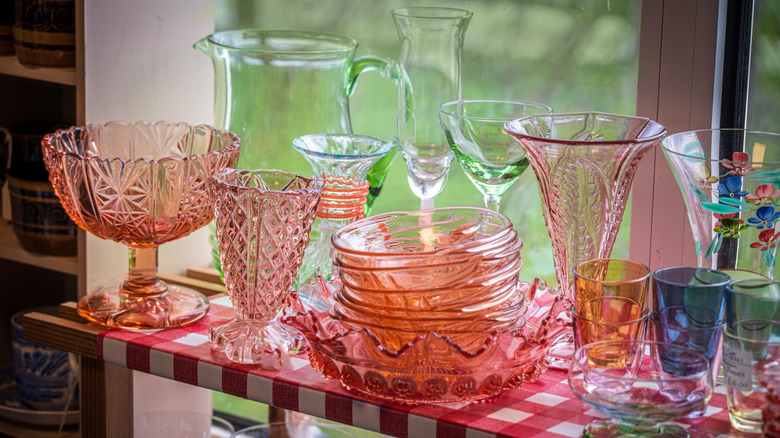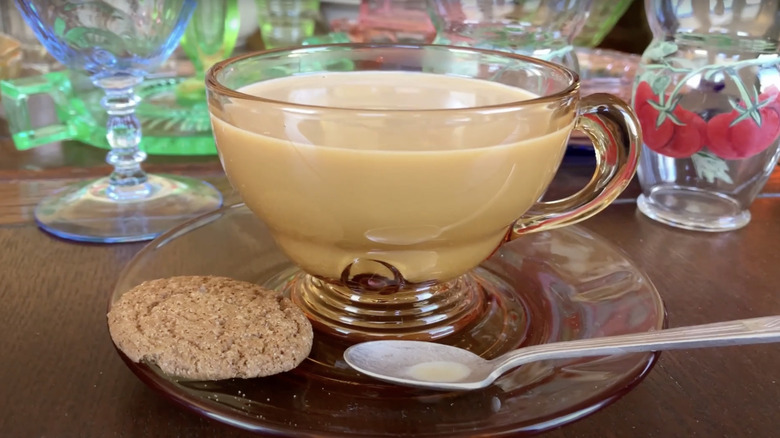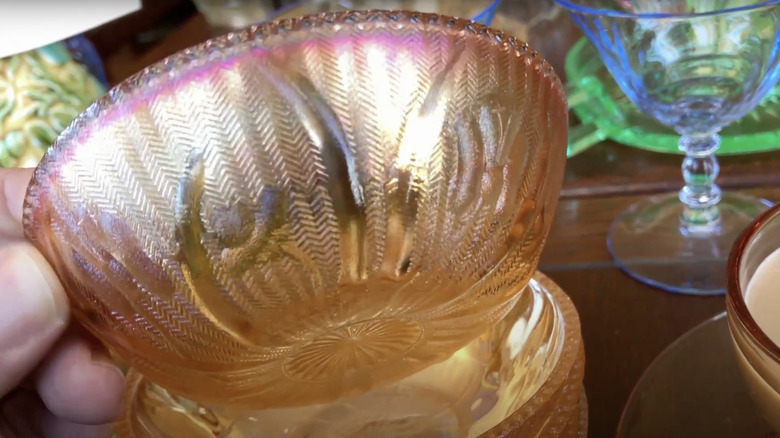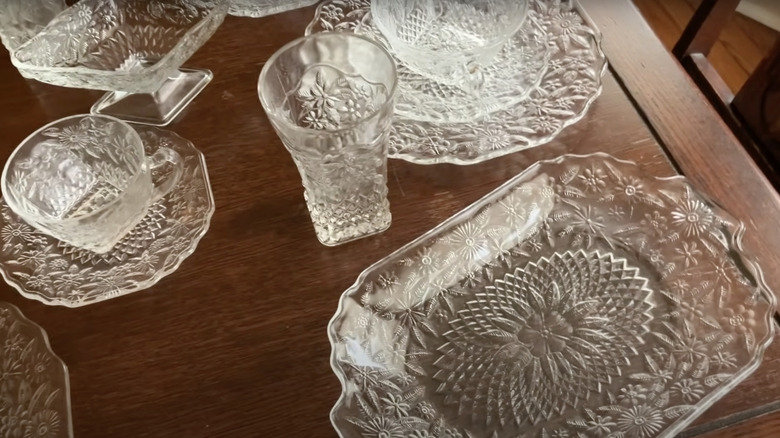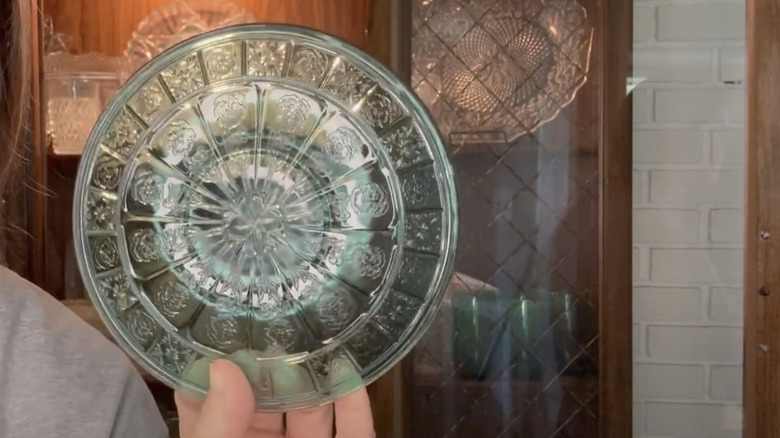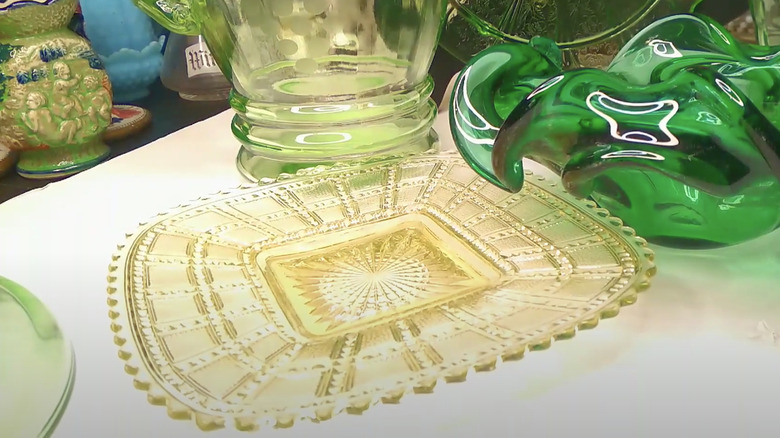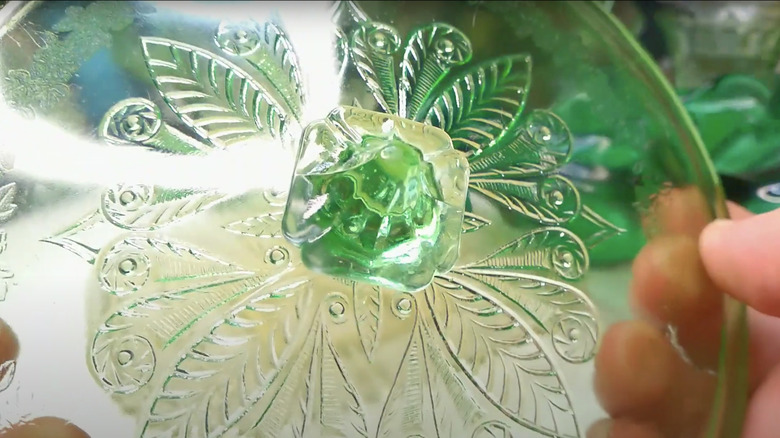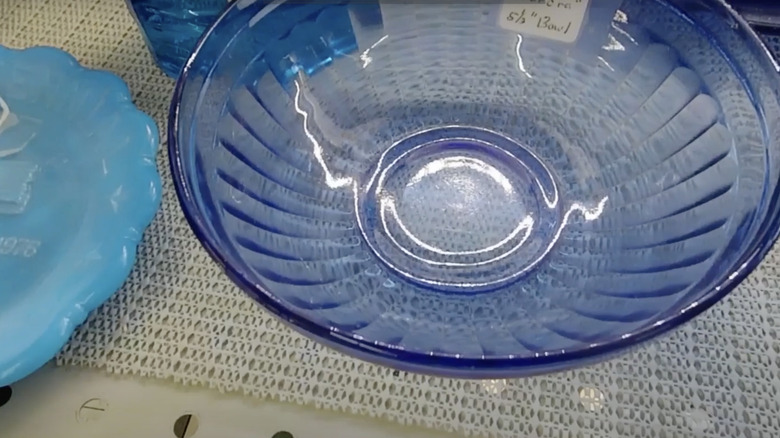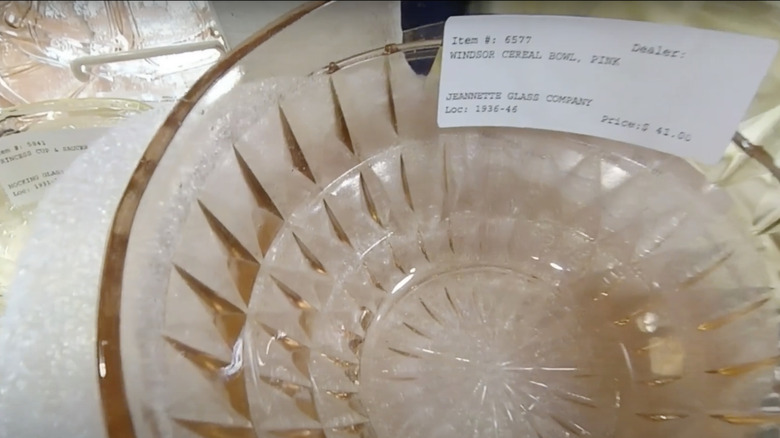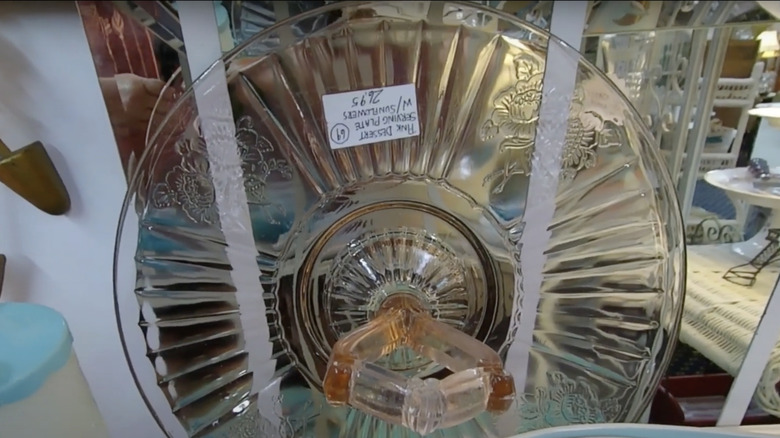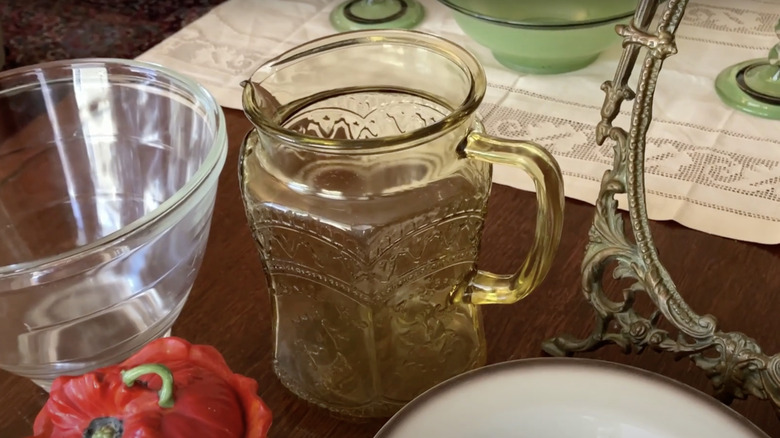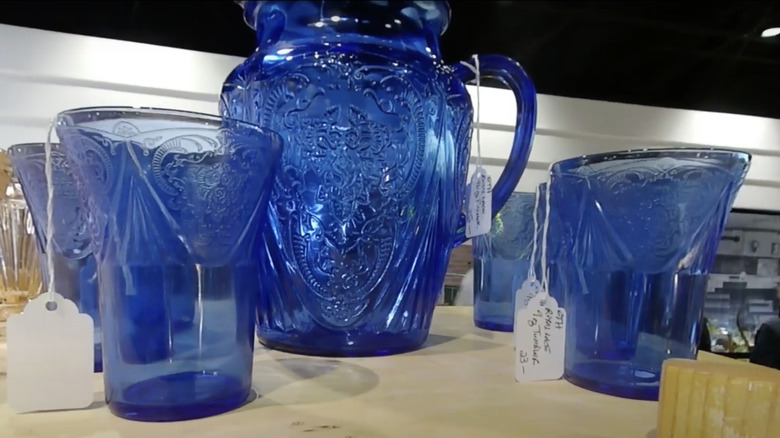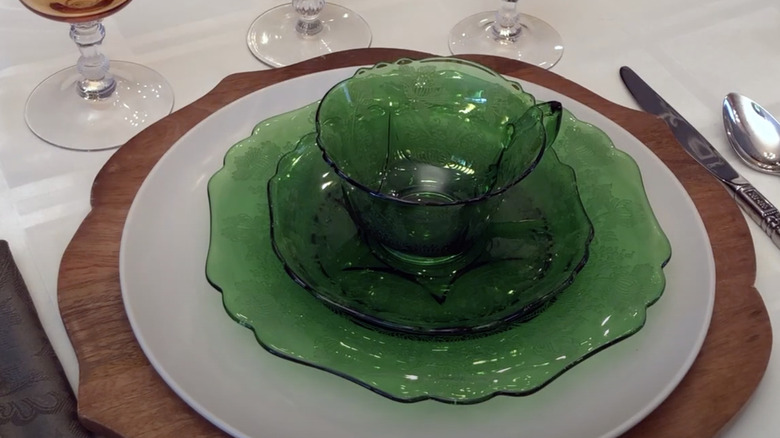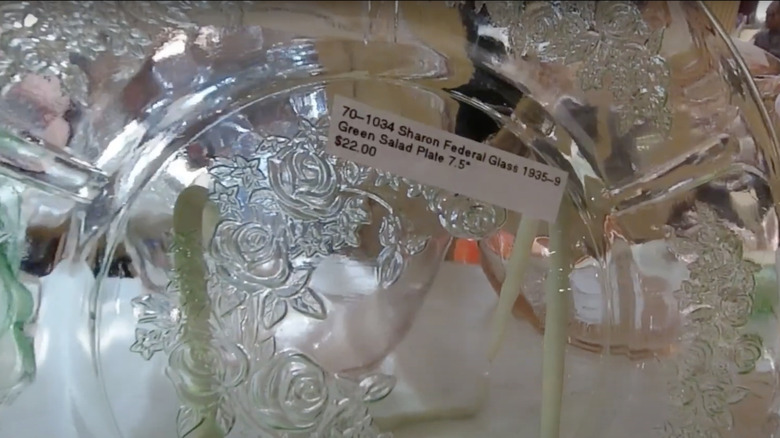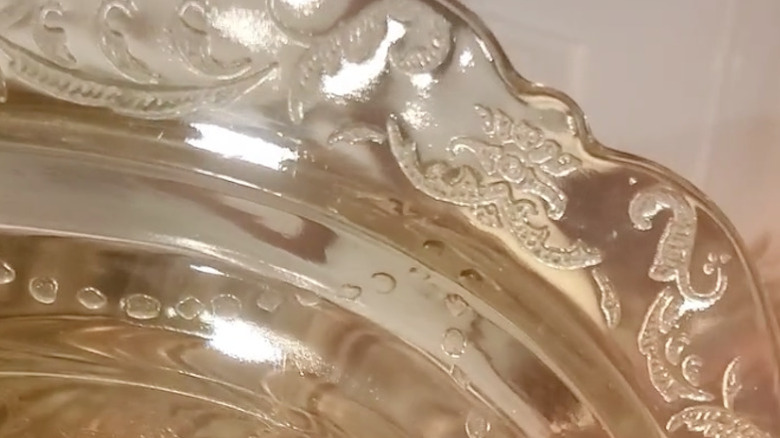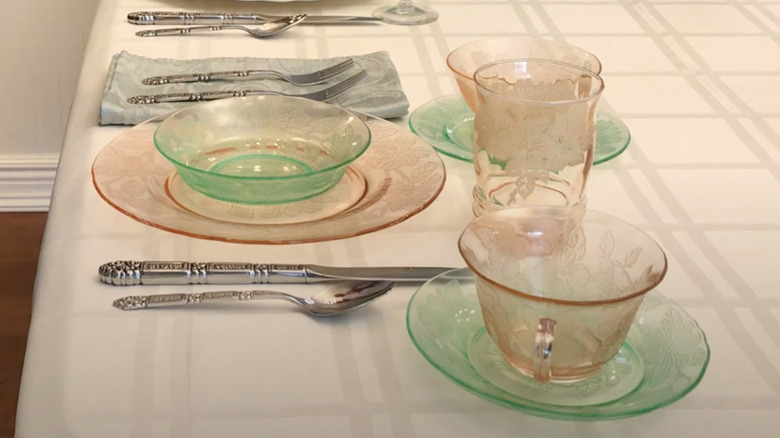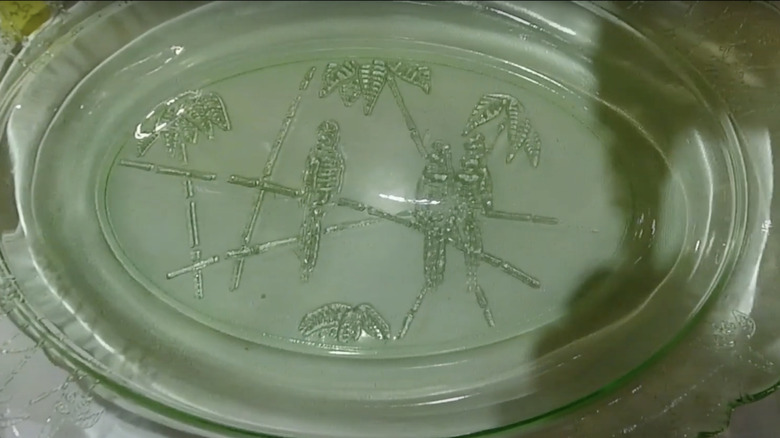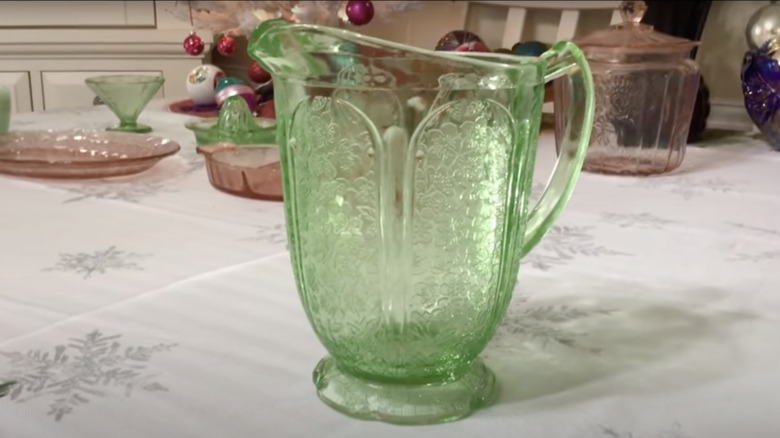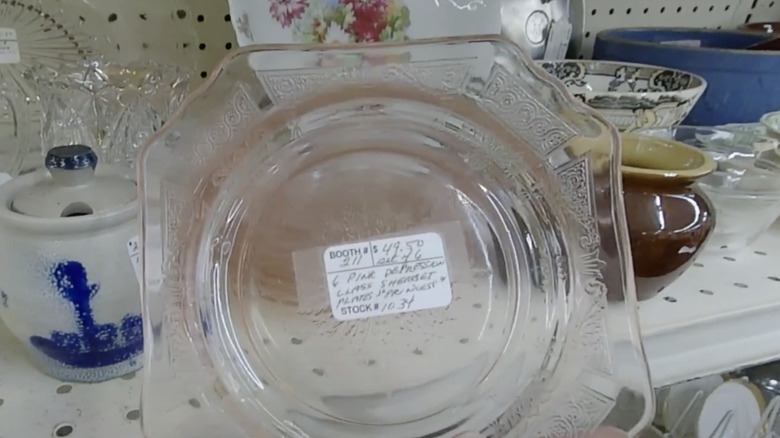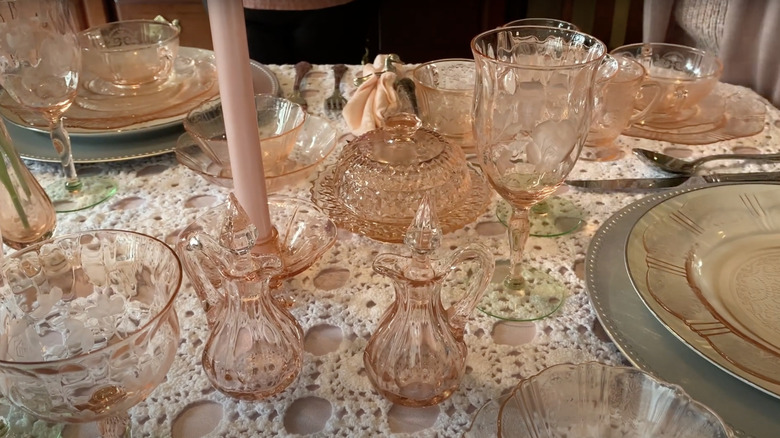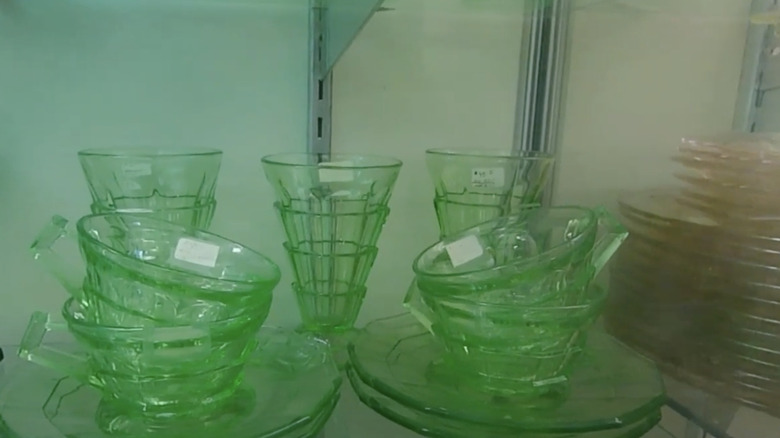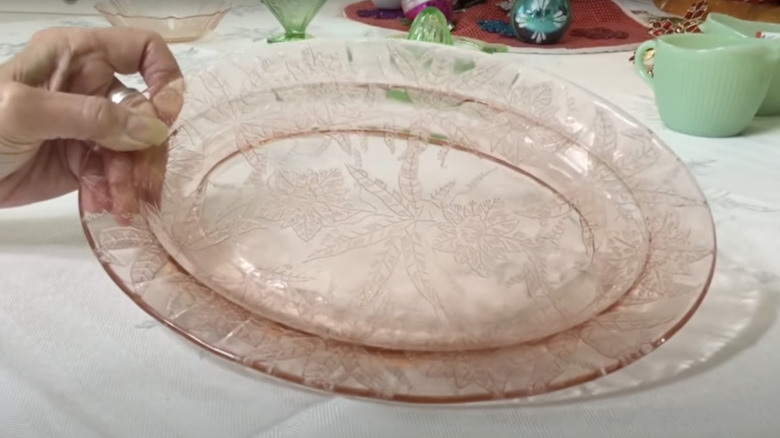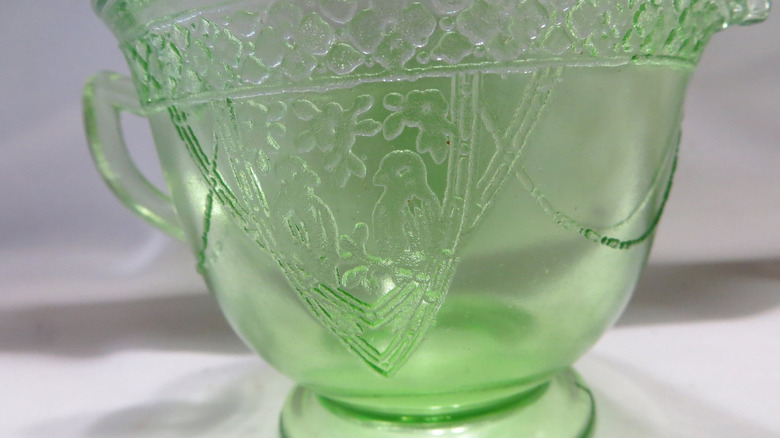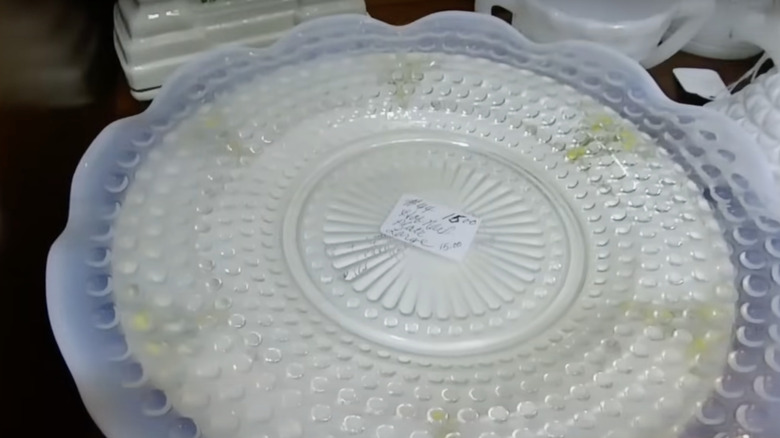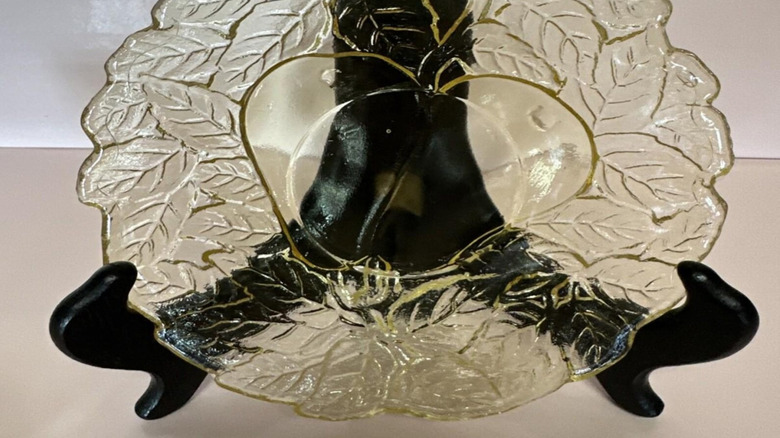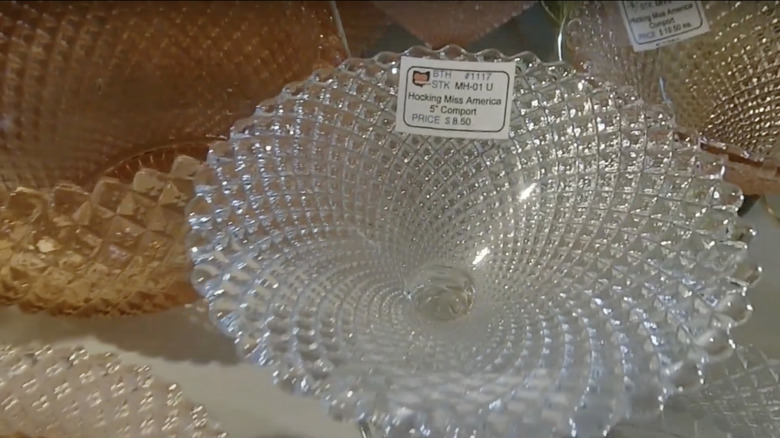27 Depression Glass Patterns You Should Always Keep An Eye Out For At The Thrift Store
Whether you're looking for vintage dishware brands to bring your kitchen retro charm or some cute items to fill that new antique hutch, Depression glass will fit the bill. The home-proud objects come in candy-sweet hues and, perhaps most importantly, an incredible selection of patterns. Collector favorites to look out for include Hocking Glass' Miss America, American Sweetheart by Macbeth-Evans, or Gloria by Cambridge Glass Company in forest green. For the minimalist thrifter, frill-free options include Hocking's Optic Block and Windsor by Jeannette. Birders should try to find Parrot or Lovebirds (officially Georgian), both by Federal Glass. Want a piece that marks the very beginning of the Depression glass craze? Keep your eyes peeled for Indiana Glass Company's No. 601, also known as Avocado or Sweet Pear.
What is Depression glass, you ask? During the Great Depression, stores and food companies handed out affordable, mass-produced glassware to customers as an encouragement to keep buying their products despite diminutive household budgets. The tableware is occasionally called oatmeal glass because you could get pieces for free inside boxes of oatmeal or by sending in clipped coupons. Today, people like Depression glass because of its history — it quite literally brings a story of resilience in hard times to the table. Original pieces have flaws, seam lines, crisp patterning, thin glass, and maker's marks (in some cases). If you're unsure which pattern you've discovered while thrifting or of its authenticity, consult online catalogs, join a Depression glass society, or get pick up a book on the subject. "Warman's Depression Glass Handbook: Identification, Values, Pattern Guide" by Ellen Schroy costs around $20 and is rated highly.
Look for ballerinas to identify Anchor Hocking's Pretty Cameo glass
Pretty Cameo, or just Cameo for short, is a popular Depression glass pattern that's fondly called Ballerina or Dancing Girl by collectors because the dishes sport performing feminine figures. It was made by Ohio-based Anchor Hocking (formerly Hocking Glass Company), a company that still exists today, for just five short years (1930 to 1934). Despite this short run, it's common enough to be affordable for new collectors. Expect to find this top-ranking pattern in green glass, but if you come across yellow, pink, or crystal pieces, snap them up.
Snap up Moondrops patterned wares by New Martinsville Glass when you see them
While Moonstone and Radiance were the most popular New Martinsville Glass Manufacturing Company patterns, Moondrops isn't far behind. Pictured here is the high-quality polished glass amber Moondrops cup and saucer, a discontinued line produced between 1932 and 1940, but patterns span cobalt (blue), ruby (red), green, clear, and uranium hues, too. It also goes by line #37 in manufacturing speak. In particular, the company's cobalt footed perfume bottles are extremely rare, with only a handful ever being found, and therefore highly sought after by collectors.
Depression glass collectors covet the Iris and Herringbone pattern by Jeannette
To identify the popular Iris and Herringbone pattern by Jeannette Glass Company, look for molded iris flowers set against a herringbone backdrop. If you're after true Depression era pieces, avoid the iridescent Iris and Herringbone patterned wares. While they have the exact same pattern, they were mostly manufactured in the 1950s. Instead, look for clear (the most common color), pink, or green, all produced between 1928 and 1932. Note, too, that this pattern is so popular that it's been reproduced often. Be careful not to get fooled by dupes.
Get fruity with Pineapple and Floral by Indiana Glass Company
Pineapple and Floral (No. 618) was launched by Indiana Glass Company in 1932 and is easily recognizable by the circular pineapple-like motif in the center of dishes. Crystal is the most common color, though limited pieces were also released in amber and pale green. The clear Pineapple and Floral wares were made right up to the 1990s, so identifying an authentic Depression-era glass in this pattern can be challenging for new collectors. Still, it's a good starter pattern since it's moderately sought after and not too expensive.
Doric and Doric and Pansy by Jeannette Glass give total cottagecore vibes
Doric and Doric and Pansy are popular Jeannette Glass Company patterns. Doric and Pansy features geometric square borders with molded pansies. It can be a challenging pattern to find; look instead for the more common Doric. It's the same pattern minus the blooms. Collectors particularly covet Doric and Pansy in ultramarine. It (and Doric) also comes in the clear, pink, and green or the rarer delphite (blue) and yellow. Most colors date between 1937 and 1938 with the exception of Doric green, which was first released in 1935.
Imperial's Beaded Block is an easy to spot Depression glass pattern
The Beaded Block pattern appeared on dining table accessories by the Imperial Glass Company — think candy dishes, creamer and sugar sets, vases, and small square or round plates. Look for Beaded Block in green, yellow, light blue, pink, and crystal, which all date from 1927 to 1935. Take a black light and you may also find uranium Beaded Block wares. Some people think uranium is a health hazard when thrift shopping for glass, but the dishes contain so little of the radioactive substances that they're generally perfectly safe.
Vertical ribs paired with floral motifs point to Adam by Jeannette Glass
Adam is a highly coveted and enduringly popular Depression glass pattern from the prolific Jeannette Glass Company. It was produced in small quantities between 1932 and 1934, making it rare and among the most valuable patterns. Vertical ribs radiate out from a geometric floral center, though some pieces, like lids, only feature the floral pattern while others, like sherbet dishes, have a floral border. Adam is found in pink, green, crystal, blue, or yellow. Watch out for reproductions, which started popping up in stores in the 1980s.
Love the northern lights? Hunt down Aurora by Hazel Atlas Glass Company
Aurora is a chunky ribbed Depression glass pattern that would be right at home with your mid-century vintage or even contemporary decor. It's affordable, so it regularly features in popular pattern lists. Like most of Hazel Atlas' sets, Aurora dishware — from pitchers, tumblers, and cereal bowls to creamers, plates, and more — is rarely marked; you'll need to familiarize yourself with the nuances of the pattern. Cobalt blue, dating from 1935, is most common in thrift stores. Clear, pink, and green pieces exist, but in far fewer numbers.
Celebrate royally if you find a Windsor patterned dish by Jeannette
Windsor by Jeannette Glass Company is often called Windsor Diamond by collectors due to the diamond-like faceting that covers almost the entire surface of a plate or vessel. Dishware with the iconic Windsor pattern was made throughout the decade after 1936 and the pattern can be found in green, pink, and crystal. If you love Windsor or Windsor Diamond but are struggling to get your hands on anything in the pattern, the later Holiday (also called Buttons and Bows) pattern is similar to this true Depression era decoration.
Pricey Mayfair by Hocking Glass is a lucky thrift find
Mayfair, also called Open Rose, by the Hocking Glass Company easily makes the list of the most popular Depression glass patterns. It's relatively rare, making it highly valuable, and therefore a pattern you want to snatch up if you're lucky enough to spot it. Look for molded roses between thick ribs. Mayfair servingware is most often pink, but was also made in blue, crystal, yellow, and green. If you only manage to find something small, channel TikTok's clever use for spare glass pieces and turn it into a candle holder.
Identify Patrician by Federal Glass by its circular spoked wheel design
Patrician by Federal Glass Company is fondly called Spoke by collectors because the pattern features a central circle in the shape of a spoked wheel. Look for that to identify Patrician dishware in the thrift store. The pattern was never reproduced, so it's a safe bet for new collectors. Pieces made in this pattern were only made between 1933 to 1937, but so many were made that most were used everyday. That means anything you find is likely to have cutlery marks. Amber is the most common color.
Hocking's Block Optic is an easy start for Depression glass collectors
Love minimalist patterns? Keep an eye out for Block Optic by Hocking Glass Company when you're browsing thrift store shelves. It's an early pattern of thick horizontal ribs surrounding a plain or minimally patterned center, produced between 1929 to 1933 during the height of the Great Depression. Block Optic dishware comes in yellow, pink, green, and clear. A limited quality of blue was manufactured, too. It was produced in abundance by Hocking; there were at least 56 different pieces made with this pattern, making it easy to find.
You'll bag a bargain if you find Royal Lace pieces
A dish in Royal Lace is easily one of, if not the most valuable glass items you should be looking for at thrift stores and estate sales. The beloved pattern was made by Hazel-Atlas Glass Company between 1934 and 1941. Look for it in blue, pink, green, amethyst (closer to burgundy in hue), and clear. The blue is particularly coveted by collectors today; it was also popular when the dishes were new. Don't be fooled by reproductions, though, which are most often blue and span cookie jars and tumblers.
Look for scalloped edges and florals to identify Gloria by Cambridge Glass
The Gloria pattern by Cambridge Glass Company — released in 1931 and produced for seven more years — features upward-reaching florals etched into scalloped-edged, sometimes gold-rimmed dishware. It was popular in its day, though rare today; the pattern is much sought after by aficionados looking to complete their collections. If you stumble across a Gloria patterned dish in forest green, snap it up. The hue is hard to find and, as such, favored by collectors. You're more likely to come across Gloria decorated wares in crystal, yellow, or pink.
Federal's Sharon is a popular Depression glass pattern worth picking up
Sharon, nicknamed Cabbage Rose or Rose of Sharon, by Federal Glass Company features individual bouquets of cabbage roses between vertical dividers. The pattern is easily recognizable, making Sharon a (mostly) reliable find. The Sharon collection boasts 30 pieces, from dinner plates and breakfast bowls to teacups and salt shakers, manufactured between 1935 and 1939. Original colors include pink, amber, green, and clear. Reproductions are out there, mostly in pink and blue (which is never original), so check any pink wares you come across carefully for signs of authenticity.
The Madrid pattern by Federal Glass overflows with twirling florals
Madrid by Federal Glass Company is a popular pattern featuring dishes elaborately decorated with baroque-esque beading, ribbons, scrollwork, and florals. It was produced from 1932 to 1939 in amber, green, clear, rare blue and pink, and iridescent (in which only 3 pieces were made), though it's been reproduced often, especially in pink. For example, Indiana Glass Company released a series called Recollection, made on new but similar molds, in 1976. Brush up on how to spot authentic Depression glass when shopping at estate sales if you're enamoured with this pattern.
Macbeth-Evans' Dogwood features huge blossoms in pink or green glass
Dogwood is a whole-dish etched pattern of large brocade-like blooms made by the Macbeth-Evans Glass Company. It's an early-era Depression pattern and somewhat rare since it was made over just four years between 1929 and 1932 (or possibly 1930 to 1934). There's a full Dogwood dinnerware service in pastel pink, but only a breakfast set in light green. Mix and match pieces in the two colors for a cute table setting. If a thrift store piece is labeled Wild Rose or Apple Blossom, it's also Dogwood. Those are collector names.
Put crackers on your Polly, er Parrot Depression glass
Though the Federal Glass Company officially dubbed this pattern Sylvan, collectors call it Parrot due to the molded birds perched on palm trees. While it's very easy to identify, you don't see it in thrift stores very often. Why? The story goes that the 1931 pattern had a lot of blank space that showed scratches from cutlery, especially on the plates. As a result, it was discontinued after just one year and replaced with the highly decorative Madrid. The cream and sugar sets in this pattern are particularly popular with collectors.
Cherry Blossom by Jeannette: great for new Depression glass collectors
Cherry Blossom, shortened to Cherry by collectors, was manufactured by Jeannette Glass Company between 1930 and 1939. It is the only pattern to hit the stores — or oatmeal boxes — throughout the Depression. Cherry is a staple pattern, making it a good starting point for new collectors. Look for blossom collages radiating out from a central cherry, flower, and leaf bouquet on dishes. Pink and green are common, while clear, yellow, delphite, and jadeite are rare. Cherry Blossom started being reproduced in the early 1970s, so check pieces carefully before buying.
Into Princesscore? You'll love Hocking's Princess Depression glass
Princess was one of Hocking Glass Company's most popular dishware patterns during the Great Depression (1931 to 1935) and a top five pattern for today's collectors. Dishes with the Princess pattern feature stylized clusters of hanging blooms reminiscent of wisteria racemes and geometric designs. You're most likely to find cups, saucers, and footed sherbets in thrift stores. Among the various hues, pink is most popular, and green, topaz (yellow), and apricot are relatively common. Blue items were made, but only in four shapes: cup, saucer, cookie jar, and grill plate.
American Sweetheart by Macbeth-Evans is (arguably) prettiest in pink
American Sweetheart sits comfortably among the highest valued and most popular Depression glass patterns. It was also one of Macbeth-Evans Glass Company's most popular patterns in the pre-war period. The pattern features a center full of paisleys and curlicues with ribbed edges. American Sweetheart was made in a soft pink, deep cobalt, red, and a milky white glass called Monax. One way to spot American Sweetheart in the latter is that the edges are translucent with a blue sheen. You're most likely, however, to find the dishes in pink.
Indiana Glass' rare Tea Room pattern is a thrifting boon
Geometric lines and Art Deco vibes define the Tea Room pattern by Indiana Glass Company. It's so sleek you would think it was a vintage-inspired find for your modern home rather than a true Depression glass. What's more, many of the pieces in the 56-strong Tea Room collection are rare today, especially in the little-made amber and crystal hues, making this pattern a collector's dream. Some pieces are colored with uranium, so they glow in black light. Tea Room pieces were made for a very short time: 1926 to 1931.
Find the perfect festive dinnerware in Jeannette's Floral pattern
Floral, also called Poinsettia by collectors, was made by the Jeannette Glass Company between 1931 and 1935 and featured on cookie jars, bowls, serving dishes, jugs, vases, coasters, pitchers, and more. The pattern is easy to identify because the flowers look like their botanical collectors' namesake. Floral pieces also boast fluted edges. Pink and green are most common in thrift stores; it also comes in Delphite blue, crystal, Jadeite, crystal, amber, and red. If you find shakers in cobalt blue or dark green, leave them on the shelf. They're reproductions.
Get romantic with Georgian by Federal
Georgian was one of Federal Glass Company's most popular lines and still excites collectors today. The pattern is fondly referred to as Lovebirds by devotees because, you guessed it, the dishes sport a pair of molded lovebirds alternating with baskets. Georgian was made predominantly in green (including black-light activated uranium), but also in smaller numbers in amber and clear, between 1931 and 1936. Full sets of tableware were made in this pattern, so pretty much any type of dish is up for grabs. Best of all, it has never been reproduced.
Take your dinner guests into space with Hocking's Moonstone
Moonstone is a hobnail pattern by Hocking Glass Company; dishes in this pattern appear to be covered in concentric circles of glistening, perfectly round dewdrops in various sizes. They're typically arranged around a central geometric crown. Some pieces have ruffled edges while others are round. The pattern is rare and converted by collectors because it was only produced between 1942 and 1946. Hocking released Moonstone on small dinnerware sets — think plates, cups, goblets, creamer, and sugar — in opalescent clear, red, and green, with the former being the most common.
Indiana Glass takes the idea of a fruit platter seriously with Avocado
The Indiana Glass Company called this pattern No. 601, and it has since been dubbed Avocado or Sweet Pear by collectors due to the two large fruits sitting in the center of each dish. If you're interested in collecting the earliest forms of Depression glass, keep an eye out for Avocado while thrifting. The pattern was first released way back in 1923 and was manufactured for a decade before being discontinued. Look for the pattern in green, pink, and the harder to find clear tableware.
Crown yourself (or your guests) with Hocking Glass' glitzy Miss America
Miss America was manufactured by Hocking Glass Company between 1933 and 1936, 1937, or 1938. It's a collector favorite. Pink pieces are the most sought after, but the pattern is also available in green, clear, ruby (red), and blue. Spot Miss America by its sharp hobnails that catches the light similarly to crystal. Miss America comes in most Hocking shapes bar candle holders; the large five-sectioned relish is rarest. The pattern has been reproduced since the 1970s on pitchers, tumblers, butter dishes, and shakers in many inauthentic colors.
